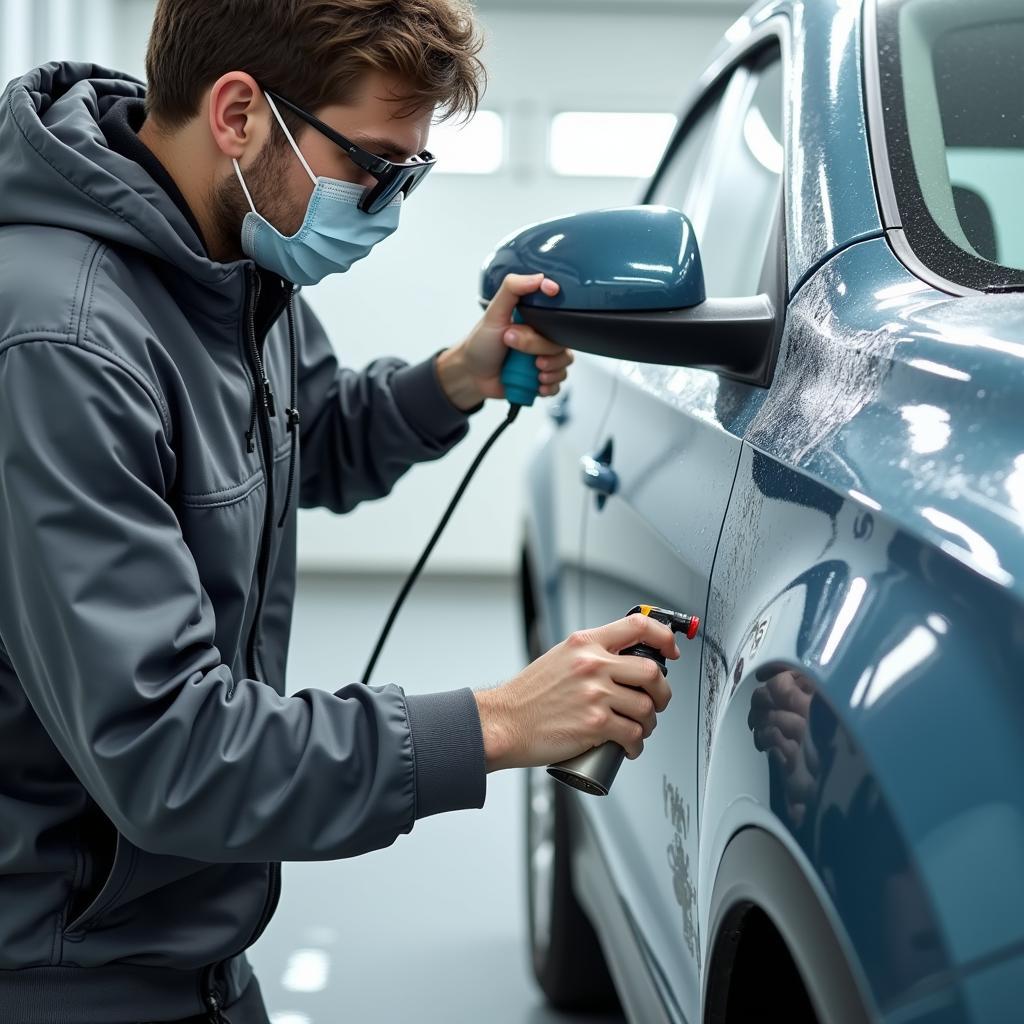Repairing and painting a hole in your car door can seem daunting, but with the right tools and a bit of patience, it’s a manageable DIY project. This guide will walk you through the steps to effectively repair and paint that pesky hole, restoring your car door to its former glory.
For minor holes and dings, sometimes a simple touch-up is all you need. Check out our guide on car spot repair paint for quick fixes.
Assessing the Damage: The First Step in Car Door Hole Repair
Before diving into the repair, carefully assess the extent of the damage. Is it a small puncture, a larger dent with a hole, or a significant area of damage? The size and type of hole will determine the necessary repair method. A small hole might only require filler and paint, while a larger one might need a patch. Examine the surrounding area for any rust, which will need to be treated before proceeding.
Gathering Your Tools and Materials for the Repair
Having the correct tools and materials on hand will make the repair process much smoother. You’ll need:
- Sandpaper (various grits)
- Body filler (Bondo)
- Body filler spreader
- Primer
- Automotive paint (matched to your car’s color)
- Clear coat
- Masking tape and paper
- Safety glasses and gloves
- Tack cloth
- A sanding block
- Metal patch (if needed)
- Welding equipment (if patching with metal)
Repairing the Hole: A Step-by-Step Guide
- Clean the Area: Thoroughly clean the area around the hole with soap and water, then dry it completely. Remove any loose paint or rust.
- Sand the Area: Using coarse sandpaper, sand the area around the hole to create a rough surface for the filler to adhere to. Feather the edges to blend with the surrounding paint. For rust repair, refer to our guide on car body rust repair and paint.
- Apply Body Filler (if no patch is needed): Mix the body filler according to the manufacturer’s instructions. Apply it to the hole using a spreader, ensuring it fills the hole completely and slightly overlaps the surrounding area.
- Sand the Filler: Once the filler dries, sand it smooth using progressively finer grits of sandpaper. Start with a coarser grit and work your way up to a finer grit for a smooth finish.
- Apply a Metal Patch (if needed): If the hole is large, you might need to weld a metal patch onto the door. Ensure the patch fits snugly and weld it securely. Grind down the weld seams smooth. You might consider getting help with small paint repair jobs for cars in your area if welding is required.
- Prime the Area: Apply a thin, even coat of primer to the repaired area. Let it dry completely.
Painting the Repaired Area
- Mask the Surrounding Area: Use masking tape and paper to protect the surrounding area from overspray.
- Apply the Base Coat: Apply several thin coats of automotive paint, allowing each coat to dry before applying the next. Ensure the color matches your car’s paint. If you’re dealing with chipped paint, check out our guide on car chipped paint repair.
- Apply Clear Coat: After the base coat dries, apply a few coats of clear coat to protect the paint and give it a glossy finish.
- Remove the Masking Tape: Carefully remove the masking tape once the clear coat is dry.
Tips for a Professional Finish
- Use thin coats of paint and primer to prevent runs and drips.
- Sand between each coat of filler and primer for a smooth surface.
- Use a tack cloth to remove any dust or debris before painting.
- Work in a well-ventilated area.
“Proper preparation is key to a successful car door repair,” says John Smith, Automotive Repair Specialist at Smith’s Auto Body. “Taking the time to properly assess the damage and gather the right materials will make the process much easier and result in a better finish.”
 Painting a Repaired Car Door
Painting a Repaired Car Door
Conclusion
Repairing and painting a hole in your car door requires patience and attention to detail, but the results are well worth the effort. By following these steps, you can restore your car door to its original condition and save money on costly repairs. If you’re looking for expert assistance, particularly in Abingdon, consider Paint Tech car body repair Abingdon. Remember, a well-executed repair can make all the difference in maintaining the appearance and value of your vehicle.
FAQ
- What type of filler should I use? Use a two-part automotive body filler.
- Can I repair a rust hole myself? Yes, but it’s crucial to remove all the rust before repairing the hole.
- How many coats of paint should I apply? Apply several thin coats, allowing each to dry before the next.
- Do I need a clear coat? Yes, a clear coat protects the paint and gives it a glossy finish.
- What if I’m not comfortable welding? Consider professional help for welding repairs.
- Can I just use touch-up paint for a small hole? For very small chips, touch-up paint might suffice, but for larger holes, filling and repainting is necessary.
- How long does the repair process take? The drying times for filler, primer, and paint can vary, but allow for at least a day for the entire process.
Need help with other car repairs? Check out our guides on small paint repair jobs for cars palm springs area and car chipped paint repair.
For any assistance, please contact us via WhatsApp: +1(641)206-8880, or Email: [email protected]. Our customer service team is available 24/7.

